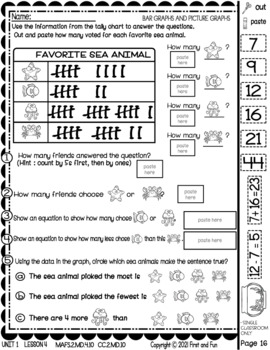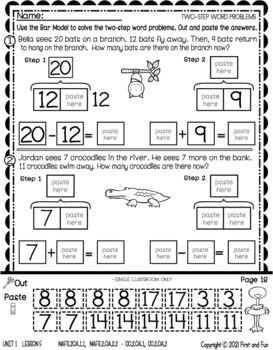NO PREP CUT & PASTE 2ND GRADE ADDITION STRATEGIES iREADY MATH UNIT 1 LESSONS 1-5
- PDF
Also included in
- NO PREP CUT AND PASTE 2ND GRADE ADDITION STRATEGIES iREADY MATH UNIT 1 LESSON 1 to 5This pack is a great addition to any Second Grade Math Curriculum. It offers students practice in understanding adding and subtracting numbers within 20 as well as how to use and draw graphs. Students will developPrice $14.00Original Price $16.00Save $2.00
Description
NO PREP CUT AND PASTE 2ND GRADE ADDITION STRATEGIES iREADY MATH UNIT 1 LESSON 1 to 5
This pack is a great addition to any Second Grade Math Curriculum. It offers students practice in understanding adding and subtracting numbers within 20 as well as how to use and draw graphs. Students will develop strategies for building a strong foundation for success in math.
There are 19 pages (3-5 pages for each lesson) of cut and paste work sheets that will keep your students engaged and learning while having fun. Great for interactive note books / math journals and math centers.*Created with ANIMAL themed clip art.
Lesson 1: MENTAL MATH STRATEGIES FOR ADDITION UNIT 1 LESSON 1 - Standards: MAFS.2.OA.2.2 / CC.2.OA.2
Lesson 2: MENTAL MATH STRATEGIES FOR SUBTRACTION UNIT 1 LESSON 2 -Standards: MAFS. 2OA.1.1, MAFS.2.OA.2.2 / CC.2.OA.2
Lesson 3: 2ND GRADE ONE-STEP WORD PROBLEMS iREADY MATH UNIT 1 LESSON 3- Standards: MAFS.2.OA.2.1, MAFS.2.OA.2.2 / CC.2.OA.1, CC.2.OA.2
Lesson 4: 2ND GRADE USE AND DRAW GRAPHS iREADY MATH UNIT 1 LESSON 4 - Standards: MAFS.2.MD.4.10 / CC.2.MD.10
Lesson 5: 2ND GRADE TWO-STEP WORD PROBLEMS iREADY MATH UNIT 1 LESSON 5 - Standards: MAFS.2.OA.2.1, MAFS.2.OA.2.2 / CC.2.OA.1, CC.2.OA.2
*These worksheets are great for interactive notebooks, math journals, centers or distance learning. You can print out for morning work or homework. You can buy the bundle and have a year-round No Prep Cut and Paste Center, just leave scissors and glue stick out for the students.
ALSO AVAILABLE: iReady: Differentiated practice worksheets Pack with Posters and exit tickets for the whole year for Kindergarten, First Grade, and Second grade.
Remember this is intended for one classroom only. If you enjoy my product please consider following me on Teacher Pay Teachers store and rate my down load.
Please email me if you have any question. I can adjust any part of the product to meet the needs of your students.
svrdesign@earthlink.net
Also available: Kindergarten and First Grade No Prep Cut and Paste products.
This file is an independent product and is not affiliated with, nor has been authorized, sponsored, or otherwise approved by Pearson®, Always Learning®, Scott Foresman®, Pearson Scott Foresman®, or enVisionMath®, Curriculum Associates®
**Remember to leave feedback to earn your TPT Credits!**






